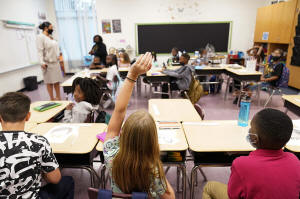US children fall further behind in reading, make little improvement in
math on national exam
 Send a link to a friend
Send a link to a friend
 [January 29, 2025]
By COLLIN BINKLEY [January 29, 2025]
By COLLIN BINKLEY
WASHINGTON (AP) — America’s children have continued to lose ground on
reading skills in the wake of the COVID-19 pandemic and have made little
improvement in math, according to the latest results of an exam known as
the nation’s report card.
The findings are yet another setback for U.S. schools and reflect the
myriad challenges that have upended education, from pandemic school
closures to a youth mental health crisis and high rates of chronic
absenteeism. The national exam results also show growing inequality:
While the highest-performing students have started to regain lost
ground, lower-performing students are falling further behind.
Given every two years to a sample of America’s children, the National
Assessment of Educational Progress is considered one of the best gauges
of the academic progress of the U.S. school system. The most recent exam
was administered in early 2024 in every state, testing fourth- and
eighth-grade students on math and reading.
“The news is not good,” said Peggy Carr, commissioner of the National
Center for Education Statistics, which oversees the assessment. “We are
not seeing the progress we need to regain the ground our students lost
during the pandemic.”
Among the few bright spots was an improvement in fourth grade math,
where the average score ticked up 2 points on a scale of 500. It’s still
3 points lower than the 2019 pre-pandemic average, yet some states and
districts made significant strides, including in Washington, D.C., where
the average score increased 10 points.
For the most part, however, American schools have not yet begun to make
progress.

The average math score for eighth grade students was unchanged from
2022, while reading scores fell 2 points at both grade levels. One-third
of eighth grade students scored below “basic” in reading, more than ever
in the history of the assessment.
Students are considered below basic if they are missing fundamental
skills. For example, eighth grade students who scored below basic in
reading were typically unable to make a simple inference about a
character's motivation after reading a short story, and some were unable
to identify that the word “industrious” means “to be hard working.”
Especially alarming to officials was the divide between higher- and
lower-performing students, which has grown wider than ever. Students
with the highest scores outperformed their peers from two years ago,
making up some ground lost during the pandemic. But the lowest
performers are scoring even lower, falling further behind.
It was most pronounced in eighth grade math: While the top 10% of
students saw their scores increased by 3 points, the lowest 10%
decreased by 6 points.
“We are deeply concerned about our low-performing students,” said Lesley
Muldoon, executive director of the National Assessment Governing Board,
which sets policies for the exam. “For a decade, these students have
been on the decline. They need our urgent attention and our best
effort.”
The latest setbacks follow a historic backslide in 2022. In that year's
exam, student achievement fell across both subjects and grade levels, in
some cases by unprecedented levels.
This round of testing again featured students whose lives were disrupted
by the pandemic. When COVID hit in 2020, the fourth graders were in
kindergarten, and the eighth graders were in fourth grade.
[to top of second column]
|

A student raises their hand in a classroom at Tussahaw Elementary
school Aug. 4, 2021, in McDonough, Ga. (AP Photo/Brynn Anderson,
File)

But Carr said poor results can no longer be blamed solely on the
pandemic, warning that the nation's education system faces “complex
challenges.”
A survey done alongside the exam found in 2022 that fewer young
students were reading for enjoyment, which is linked to lower
reading scores. And new survey results found that students who are
often absent from class — a persistent problem nationwide — are
struggling the most.
“The data are clear,” Carr said. “Students who don't come to school
are not improving."
The results provide fresh fuel for a national debate over the impact
of pandemic school closures, though they're unlikely to add clarity.
Some studies have found that longer closures led to bigger academic
setbacks. Those slower to reopen were often in urban and
Democratic-led areas, while more rural and Republican-led areas were
quicker.
The new results don't show a “direct link” on the topic, Carr said,
though she said students clearly do better when they're in school.
Among the states that saw reading scores fall in 2024 are Florida
and Arizona, which were among the first to return to the classroom
during the pandemic. Meanwhile, some big school systems that had
longer closures made strides in fourth grade math, including Los
Angeles and New York City.
The success of big urban districts — 14 of which saw notable
improvement in fourth-grade math when the nation as a whole saw only
minor gains — can be credited to academic recovery efforts funded by
federal pandemic relief, said Ray Hart, executive director of the
Council of Great City Schools. Investing in efforts like intensive
tutoring programs and curriculum updates is “really proving to make
a difference,” he said.
Republicans in Congress were quick to cast blame on Democrats and
former President Joe Biden's administration.
Rep. Tim Walberg, R-Mich., chair of the House Education and
Workforce Committee, said the decline is “clearly a reflection of
the education bureaucracy continuing to focus on woke policies
rather than helping students learn and grow.”
“I’m thankful we have an administration that is looking to reverse
course,” he said in a reference to President Donald Trump.
Compared with 2019 results, eighth grade reading scores are now down
8 points. Reading scores are down 5 points in both grades. And in
fourth grade math, scores are down 3 points.

Yet officials say there's reason to be optimistic. Carr highlighted
improvement in Louisiana, where fourth grade reading is now back
above pre-pandemic levels, and in Alabama, which accomplished that
feat in fourth grade math.
Carr was especially laudatory of Louisiana, where a campaign to
improve reading proficiency resulted in both higher- and
lower-performing students exceeding 2019 scores.
“I would not say that hope is lost, and I would not say that we
cannot turn this around,” Carr said. “It's been demonstrated that we
can.”
___
Annie Ma contributed reporting from Washington, and Sharon Lurye
contributed from New Orleans.
All contents © copyright 2025 Associated Press. All rights reserved |